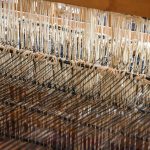You’ll notice acetate feels smoother and shinier with a cool, silky finish, while viscose offers softer comfort and better breathability due to its moisture-absorbing nature. Acetate needs gentle care or dry cleaning to keep its sheen, but viscose requires careful washing to avoid stretching or damage when wet. Both fabrics come from cellulose but differ in feel, durability, and maintenance. Keep exploring to uncover how these differences affect fashion choices.
Table of Contents
Key Takeaways
- Acetate feels smooth and slick with a shiny, glassy surface, while viscose is softer and more fibrous, resembling cotton or silk.
- Viscose absorbs moisture well, making it breathable and comfortable, whereas acetate repels moisture and can feel clammy when sweaty.
- Acetate retains shape better and resists stretching, but viscose weakens when wet and may lose its shape.
- Acetate requires dry cleaning or gentle cold washing, while viscose demands delicate hand washing and careful handling to avoid distortion.
- Acetate suits glossy, formal wear and linings; viscose is ideal for casual, breathable garments like summer dresses and shirts.
Origins and Production Processes of Acetate and Viscose
Although both acetate and viscose come from cellulose, their origins and production processes differ considerably.
When you look at acetate, it’s made by chemically modifying cellulose with acetic acid, creating a fiber that’s fundamentally a cellulose acetate ester. This process involves dissolving cellulose, treating it with acetic anhydride, and then regenerating it into fibers, which gives acetate its unique properties.
On the other hand, viscose production starts by treating cellulose with sodium hydroxide and carbon disulfide, converting it into a viscous solution. You then extrude this solution through spinnerets to form fibers.
While both originate from natural cellulose, acetate undergoes acetylation, whereas viscose involves xanthation and regeneration, leading to distinct material characteristics even before you consider texture or appearance.
Texture and Appearance: How Acetate and Viscose Differ
You’ll notice acetate feels smoother to the touch compared to viscose, thanks to its slick surface.
Acetate also tends to have a brighter sheen, giving your garments a more polished look.
Meanwhile, viscose offers a softer drape that flows naturally, making it ideal for casual wear.
Surface Smoothness Comparison
When you run your fingers over acetate and viscose, you’ll notice distinct differences in their surface smoothness.
Acetate often feels sleek and polished, thanks to its smooth, almost glassy surface. This makes it pleasant to touch and gives it a cool sensation against your skin.
Viscose, on the other hand, usually has a softer, more natural texture. It feels slightly more fibrous and less slick, which can add warmth and comfort when worn.
While acetate’s surface feels consistently smooth, viscose may have subtle irregularities that remind you it’s a regenerated cellulose fiber.
Understanding these tactile differences helps you choose the fabric that best suits your comfort preferences and intended use, whether you want that silky touch or a gentler, more natural feel.
Visual Sheen and Drape
The way acetate and viscose feel under your fingertips also influences how they look and move. Acetate boasts a brilliant, almost glassy sheen that catches the light beautifully, giving your garments a luxurious and polished appearance. Its drape is smooth and fluid, allowing fabrics to flow elegantly over your body without clinging.
On the other hand, viscose offers a softer, more muted luster—less shiny but with a natural, subtle glow. Its drape is heavier and more substantial, creating flattering silhouettes that hang gracefully but with a bit more structure than acetate.
When choosing between the two, consider if you want a bright, glossy finish with light movement or a gentle sheen paired with a weightier, more defined drape.
Breathability and Comfort on the Skin
When you choose between acetate and viscose, understanding their breathability and comfort is key.
You’ll want to contemplate how each fabric absorbs moisture, feels against your skin, and handles temperature changes.
These factors directly affect how comfortable you’ll be wearing them throughout the day.
Moisture Absorption Qualities
Understanding how acetate and viscose handle moisture can help you choose the right fabric for comfort and breathability.
Acetate tends to repel moisture more than it absorbs, which means it can feel slightly clammy when you sweat.
Viscose, on the other hand, absorbs moisture more effectively, making it feel cooler and more breathable against your skin.
When deciding between the two, consider:
- Viscose’s higher moisture absorption keeps you feeling dry and fresh longer.
- Acetate’s moisture resistance may cause discomfort during heavy sweating.
- Viscose’s breathability supports better airflow, enhancing comfort in warm conditions.
Softness and Texture Comparison
Since moisture absorption affects how a fabric feels against your skin, softness and texture play a big role in overall comfort and breathability.
When you wear acetate, you’ll notice its smooth, silky surface feels cool and luxurious, but it can sometimes feel less breathable due to its denser texture.
Viscose, on the other hand, offers a softer, more natural feel that’s closer to cotton or silk, making it gentle and comfortable for extended wear.
You’ll appreciate viscose’s lightweight, breathable texture, which lets air flow more easily, helping you stay comfortable throughout the day.
Both fabrics have their unique touch, but if you prioritize a soft, breathable feel directly against your skin, viscose usually provides a more pleasant experience than acetate.
Temperature Regulation Properties
Although both acetate and viscose offer appealing textures, their ability to regulate temperature on your skin differs considerably.
Viscose, made from natural cellulose fibers, tends to be more breathable, helping you stay cool by allowing air to circulate. Acetate, on the other hand, feels smooth and silky but doesn’t wick moisture as effectively, which can make it less comfortable in hot conditions.
Here’s how they compare:
- Viscose: Breathable and moisture-absorbent, ideal for warm weather
- Acetate: Less breathable, can trap heat and moisture
- Comfort: Viscose feels cooler and more natural against your skin, acetate offers a luxurious feel but less ventilation
Knowing these differences helps you choose fabrics that match your comfort needs.
Durability and Resistance to Wear
Both acetate and viscose offer unique strengths when it comes to durability and resistance to wear, but you’ll find they perform quite differently under regular use. Acetate resists stretching and retains its shape better, making it a good choice if you want longer-lasting garments. Viscose, while softer, tends to weaken when wet and may pill or lose shape quicker. Understanding these differences helps you pick the right fabric for your lifestyle.
| Feature | Acetate |
|---|---|
| Shape Retention | High |
| Wear Resistance | Moderate |
| Reaction to Moisture | Weakens when wet |
| Pilling Tendency | Low |
| Feature | Viscose |
| Shape Retention | Moderate |
| Wear Resistance | Lower |
| Reaction to Moisture | Weakens when wet |
| Pilling Tendency | Higher |
Washing and Maintenance Guidelines
Proper washing and maintenance play an essential role in preserving the look and feel of acetate and viscose fabrics.
Both materials are delicate, so you’ll want to handle them with care to avoid damage. Acetate prefers dry cleaning, but if you choose to wash it at home, use cool water and a gentle detergent.
Viscose is more sensitive to water and agitation, so hand washing or using a delicate machine cycle is best.
Keep these tips in mind:
- Always check the care label for specific instructions.
- Avoid wringing or twisting to prevent distortion.
- Air dry flat or hang in a shaded area to maintain shape and prevent fading.
Environmental Impact and Sustainability Considerations
When you consider the environmental impact of acetate and viscose, you’ll find that their production processes and sustainability vary considerably.
Acetate is derived from cellulose but undergoes heavy chemical processing, which can release harmful byproducts if not managed properly. Its biodegradability is moderate, but the energy-intensive manufacturing means a higher carbon footprint.
Acetate’s heavy chemical processing can release harmful byproducts and contributes to a higher energy use and carbon footprint.
Viscose, often called rayon, also starts from cellulose but involves toxic chemicals like carbon disulfide, posing environmental and health risks. However, newer methods, such as lyocell production, aim to reduce these effects.
If you want a more eco-friendly choice, look for certifications or brands that use closed-loop processes minimizing waste and emissions.
Ultimately, neither fabric is perfectly sustainable, but knowing their impacts helps you make informed, responsible decisions.
Best Uses for Acetate and Viscose in Fashion
Choosing the right fabric can elevate your fashion designs, and acetate and viscose each bring unique qualities to the table. Acetate’s silky sheen and drape make it ideal for evening wear, linings, and delicate blouses.
On the other hand, viscose offers breathability and a soft feel, perfect for casual dresses, shirts, and summer wear.
Consider these best uses to maximize each fabric’s strengths:
- Acetate: Use for garments where a glossy finish and smooth texture stand out.
- Viscose: Opt for everyday clothing that benefits from comfort and moisture absorption.
- Both: Great for pieces requiring fluidity and elegance, but balance care needs accordingly.
Frequently Asked Questions
Can Acetate and Viscose Be Blended Together in Fabrics?
You can blend acetate and viscose in fabrics to combine their qualities. This mix enhances texture and drape but requires careful care since both fibers need gentle handling to maintain fabric integrity and appearance over time.
How Do Acetate and Viscose Fabrics Behave in Extreme Weather?
When the weather throws a curveball, acetate resists moisture but wrinkles easily, while viscose soaks up sweat like a sponge and feels cool but weakens when wet. You’ll want to choose based on your adventure’s demands.
Are Acetate and Viscose Hypoallergenic for Sensitive Skin?
You might find acetate less irritating since it’s smoother, but viscose can sometimes cause reactions if you have sensitive skin. Always test a small patch first, and choose natural fibers if you’re prone to allergies.
What Are the Cost Differences Between Acetate and Viscose Fabrics?
You’ll find acetate usually costs more because it’s pricier to produce and has a luxurious finish. Viscose is more affordable since it’s mass-produced from wood pulp, making it budget-friendly for everyday wear.
Can Acetate and Viscose Be Recycled After Use?
You can recycle viscose more easily because it’s biodegradable and made from natural fibers, but acetate recycling is trickier due to its synthetic components. Always check local recycling programs to see what they accept.
- Why Open-Weave Scrim Is the Secret to Stunning Event and Canopy Designs - June 26, 2025
- Creating Large-Scale Art Installations With Scrim Fabric - June 26, 2025
- Scrim Fabric in Upholstery: Understanding Its Use as a Backing Material - June 26, 2025







